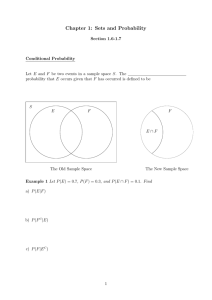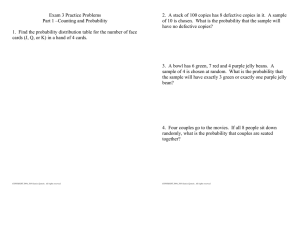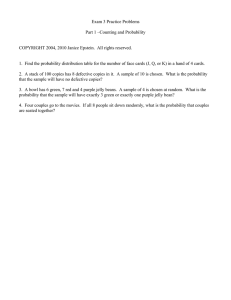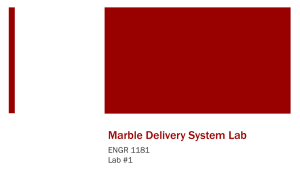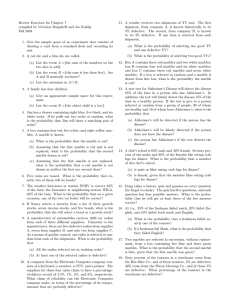Chapter 1: Sets and Probability
advertisement
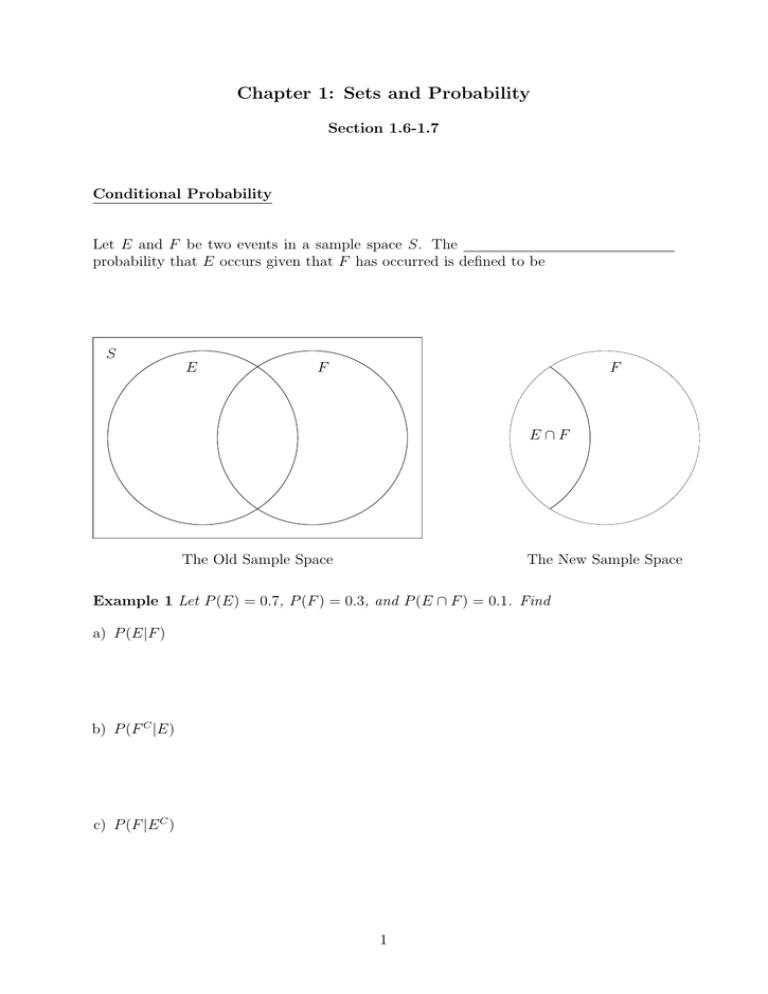
Chapter 1: Sets and Probability
Section 1.6-1.7
Conditional Probability
Let E and F be two events in a sample space S. The
probability that E occurs given that F has occurred is defined to be
S
E
F
F
E∩F
The Old Sample Space
The New Sample Space
Example 1 Let P (E) = 0.7, P (F ) = 0.3, and P (E ∩ F ) = 0.1. Find
a) P (E|F )
b) P (F C |E)
c) P (F |E C )
1
d) P (E ∪ F |F )
e) P (E C ∩ F |E)
Example 2 A pair of fair six-sided dice is rolled.
a) What is the probability that a 2 is rolled (on either one of the dice)?
b) What is the probability that the sum is less than 5 given that a 2 is rolled?
c) What is the probability that a 2 is rolled given that the sum is less than 5?
2
Example 3 The table below gives the number of students of each classification who are
majoring and not majoring in business in a class of 110 students.
Freshmen
Business
10
Non-Business
8
Total
18
Sophomores Juniors Seniors Total
17
20
12
59
3
15
25
51
20
35
37
110
A student is randomly selected from this class. Find the probability of the following events.
a) A student, who is a business major, is a freshman.
b) A freshman is a business major.
c) An underclassman given that the student is not a business major.
Product Rule: If E and F are two events in a sample space S with P (E) > 0 and
P (F ) > 0, then
Note: This is just a rearrangement of the formula for conditional probability.
If we have a sequence of experiments in which the outcomes and associated probabilities of
each experiment depend on the outcomes of the preceeding experiments, we can represent
.
this by a
3
Example 4 A jar contains 3 red marbles and 5 green marbles. Two marbles are selected
from the jar, one at a time and without replacement, and the color of each marble is
observed.
a) What is the probability that the first marble picked is green?
b) What is the probability that the second marble picked is red given that the first marble
is green?
c) What is the probability that the second marble picked is red?
d) What is the probability that the first marble picked is green given that the second marble
is red?
4
Example 5 (Tomastic/Epstein) Two machines turn out all the products in a factory, with
the first machine producing 40% of the product and the second 60%. The first machine
produces defective products 2% of the time and the second machine 4% of the time.
a) What is the probability that a defective product is produced at this factory given that
it was made on the first machine?
b) What is the probability that a defective product is produced at this factory?
Example 6 In a survey of 1000 eligible voters selected at random, it was found that
80% had a college degree. Additionally, it was found that 80% of those who had a college
degree voted in the last presidential election, whereas 55% of the people who did not have
a college degree voted in the last presidential election.
Assuming the poll is representative of all eligible voters, find the probability that an eligible
voter selected at random
5
a) had a college degree and voted in the last presidential election.
b) did not have a college degree and did not vote in the last presidential election.
c) voted in the last presidential election.
Two events E and F are said to be
if
Note: E and F are independent if the outcome of one does not effect the outcome of
the other
Independent Events Theorem: Let E and F be two events with P (E) > 0 and
P (F ) > 0. Then E and F are independent if and only if
Note: Do NOT confuse independence with two events being mutually exclusive!
Example 7 Determine if the given events E and F are independent.
a) P (E) = 0.5, P (F ) = 0.6, and P (E ∩ F ) = 0.4
b) P (E ∩ F C ) = 0.3, P (E ∩ F ) = 0.2, and P (F ∩ E C ) = 0.2
6
Example 8 Assume the events E and F are independent with P (E) = 0.3 and P (F ) =
0.6. Find P (E ∪ F ).
Example 9 A fair coin is flipped three times. Let E be the event “at most one head” and
F be the event “at least one head and at least one tail.” Are these two events independent?
A set of events {E1 , E2 , ..., En } is said to be
if, for any k of these events, the probability of the intersection of these k events is the
product of the probabilities of each of the k events. This must hold for any k = 2, 3, ..., n.
Example 10 For the set of events {E, F, G} to be independent, all of the following must
be true:
• P (E ∩ F ) = P (E)P (F )
• P (E ∩ G) = P (E)P (G)
• P (F ∩ G) = P (F )P (G)
• P (E ∩ F ∩ G) = P (E)P (F )P (G)
Note: If two events E and F are independent, then so are E and F C , E C and F , and
E C and F C . Similar statements are true about a set of events.
7
Example 11 [Tomastik/Epstein] A store sells desk kits. In each kit there is a 2% chance
that a screw is missing, a 3% chance that a peg is missing, and a 1% chance that a page
of directions is missing. If these events are independent, what is the probability that a
desk kit has exactly one thing missing?
Bayes’ Theorem
This theorem describes the probability that an event occurred, based on the information
about some conditions that might be related to the event.
Theorem: Bayes’ Theorem
et E1 , E2 , · · · , En , be mutually exclusive events in a sample space S with E1 ∪ E2 ∪
· · · ∪ En = S. If F is any event in S, then for i = 1, 2, · · · , n,
probability of branch Ei ∩ F
sum of all probabilities of all branches that end in F
P (Ei )P (F |Ei )
=
P (E1 )P (F |E1 ) + P (E2 )P (F |E2 ) + · · · + P (En )P (F |En )
P (Ei |F ) =
Note: The original formula is just P (E|F ) = P (E∩F )/P (F ), in which P (F ) is calculated
by summing over all the different ways that F can occur.
Example 12 Marie is getting married tomorrow, at an outdoor ceremony in the desert.
In recent years, it has rained only 5 days each year. Unfortunately, the weatherman has
predicted rain for tomorrow. When it actually rains, the weatherman correctly forecasts
rain 90% of the time. When it doesn’t rain, he incorrectly forecasts rain 10% of the time.
What is the probability that it will rain on the day of Marie’s wedding?
A1 : It rains on Marie’s wedding.
A2 : It doesn’t rain on Marie’s wedding.
B : The weatherman predicts rain.
8
Example 13 The following describes a cancer testing scenario using the mammogram
test. The probability of a random woman in the US having cancer is 1%. 80% of the
mammograms detect breast cancer when it is there (true positive). 9.6% of the mammograms detect breast cancer when it is not there (false positive). Find the probability that
a woman has cancer given that the mammogram test came out positive.
Test Result
Test Pos.
Test Neg.
Cancer (1%) No Cancer (99%)
80%
9.6%
20%
90.4%
Example 14 [Tomastik/Epstein] A typical box of 100 transistors contains only 1 defective one. It is realized that among the last 10 boxes, one box has 10 defective transistors.
An inspector picks a box at random, and the first transistor selected is found to be defective. What is the probability that this box is the bad one.
9
Example 15 [Tomastik/Epstein] In the problem described in Example 5, given a defective product, what is the probability it was produced on the first machine?
Example 16 [Tomastik/Epstein] Two cards are drawn in succession without replacement
from a standard deck of 52 playing cards.
a) What is the probability that the first card drawn was a spade given that the second card
drawn was not a spade?
b) What is the probability that the first card drawn was a heart given that the second card
drawn was a diamond?
10
